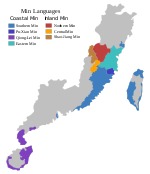Putian dialect
Appearance
(Redirected from Wuqiu dialect)
| Putian | |
|---|---|
| Pó-chéng-uā / 莆田話 | |
| Native to | Southern China |
| Region | Putian, Fujian |
Early forms | |
| Language codes | |
| ISO 639-3 | – |
| Glottolog | puti1238 |
| Linguasphere | 79-AAA-idb |
| Putian dialect | |||||||||||
|---|---|---|---|---|---|---|---|---|---|---|---|
| Traditional Chinese | 莆田話 | ||||||||||
| Simplified Chinese | 莆田话 | ||||||||||
| |||||||||||
The Putian dialect (Pu-Xian Min: Pó-chéng-uā / 莆田話; IPA: [pʰɔu˩˩ lɛŋ˩˧ ua˩˩]) is a dialect of Pu-Xian Min Chinese spoken in urban area of Putian[further explanation needed], which is a prefecture-level city in the southeast coast of Fujian province.
Phonology
[edit]The Putian dialect has 15 initials, 40 rimes and 7 tones.
Initials
[edit]| Bilabial | Alveolar | Lateral | Velar | Glottal | |||
|---|---|---|---|---|---|---|---|
| Nasal | /m/ 麻 | /n/ 拿 | /ŋ/ 雅 | ||||
| Plosive/ Affricate |
Unaspirated | /p/ 巴 | /t/ 打 | /ts/ 渣 | /k/ 家 | /ʔ/ 烏 | |
| Aspirated | /pʰ/ 彭 | /tʰ/ 他 | /tsʰ/ 査 | /kʰ/ 卡 | |||
| Fricative | /β/* | /ɬ/ 沙 | /ɣ/* | /h/ 下 | |||
| Approximant | /l/ 拉 | ||||||
Rimes
[edit]| Open syllable | Nasal Coda /-ŋ/ | Glottal Coda /-ʔ/ | ||
|---|---|---|---|---|
| open mouth | a 鴉 | au 拗 | aŋ 江 | aʔ 壓 |
| ɒ 奥 | ɒŋ 王 | ɒʔ 屋 | ||
| o 科 | ɔu 烏 | ɔŋ 温 | ɔʔ 熨 | |
| e 裔 | ai 愛 | ɛŋ 煙 | ɛʔ 黑 | |
| ø 改 | œŋ 熊 | œʔ 郁 | ||
| ŋ 伓 | ||||
| even teeth | i 衣 | iu 油 | iŋ 引 | iʔ 益 |
| ia 夜 | iau 要 | iaŋ 鹽 | iaʔ 葉 | |
| closed mouth | u 夫 | ui 位 | uŋ 廣 | |
| ua 画 | uai 歪 | uaŋ 碗 | uaʔ 活 | |
| round mouth | y 余 | yŋ 恩 | yʔ 役 | |
| yɒ 安 | yɒŋ 羊 | yɒʔ 藥 | ||
Tones
[edit]| No. | 1 | 2 | 3 | 4 | 5 | 6 | 7 |
|---|---|---|---|---|---|---|---|
| Tones | dark level 陰平 |
light level 陽平 |
rising 上聲 |
dark departing 陰去 |
light departing 陽去 |
dark entering 陰入 |
light entering 陽入 |
| Tone contour | ˥˧˧ (533) | ˩˧ (13) | ˦˥˧ (453) | ˦˨ (42) | ˩ (11) | ʔ˨˩ (21ʔ) | ʔ˦ (4ʔ) |
| Example Hanzi | 詩巴 | 時爬 | 始把 | 試霸 | 寺罷 | 濕北 | 實拔 |
Assimilation
[edit]| Coda of the Former Syllable |
Initial of the Latter Syllable |
Assimilation | Coda of the Former Syllable |
Initial of the Latter Syllable | |
|---|---|---|---|---|---|
| Group A | Open syllable | /p/, /pʰ/ | → | remain unchanged | /β/, /ɣ/ |
| /t/, /tʰ/, /ts/, /tsʰ/, /ɬ/ | /l/ | ||||
| /k/, /kʰ/, /h/ | /ɣ/ | ||||
| /m/, /n/, /l/, /ŋ/, null initial | remain unchanged | ||||
| Group B | /-ŋ/ (nasal coda) | /p/, /pʰ/ | /-m/ | /m/ | |
| /t/, /tʰ/, /ts/, /tsʰ/, /l/, /ɬ/ | /-n/ | /n/, remain unchanged | |||
| /k/, /kʰ/, /h/, null initial | remain unchanged | /ŋ/ | |||
| /m/, /n/, /ŋ/ | /-m/, /-n/, /-ŋ/ | remain unchanged | |||
| Group C | /-ʔ/ (glottal Coda) | /p/, /pʰ/, /m/ | /-p̚/ | remain unchanged | |
| /t/, /tʰ/, /ts/, /tsʰ/, /ɬ/, /l/, /n/ | /-t̚/ | ||||
| /k/, /kʰ/, /ŋ/, /h/ | /-k̚/ | ||||
| null initial | /-ʔ/ |
Tone sandhi
[edit]Putian dialect has extremely extensive tone sandhi rules: in an utterance, only the last syllable pronounced is not affected by the rules.
The two-syllable tonal sandhi rules are shown in the table below (the rows give the first syllable's original citation tone, while the columns give the citation tone of the second syllable):
| dark level 533 |
light level 13 |
rising 453 |
dark departing 42 |
light departing 11 |
dark entering ʔ21 |
light entering ʔ4 | |
| dark level 533 |
11 | 13 | 11 | ||||
| light level 13 |
11 | 55 | 42 | 11 | |||
| rising 453 |
13 | 11 | 13 | 11 | |||
| dark departing 42 |
55 | 42 | 55 | 42 | 55 | ||
| light departing 11 |
11 | 55 | 42 | 55 | |||
| dark entering ʔ21 |
ʔ4 | ||||||
| light entering ʔ4 |
ʔ21 | ||||||
Notes
[edit]References
[edit]- ^ Mei, Tsu-lin (1970), "Tones and prosody in Middle Chinese and the origin of the rising tone", Harvard Journal of Asiatic Studies, 30: 86–110, doi:10.2307/2718766, JSTOR 2718766
- ^ Pulleyblank, Edwin G. (1984), Middle Chinese: A study in Historical Phonology, Vancouver: University of British Columbia Press, p. 3, ISBN 978-0-7748-0192-8
- ^ Hammarström, Harald; Forkel, Robert; Haspelmath, Martin; Bank, Sebastian (2023-07-10). "Glottolog 4.8 - Min". Glottolog. Leipzig: Max Planck Institute for Evolutionary Anthropology. doi:10.5281/zenodo.7398962. Archived from the original on 2023-10-13. Retrieved 2023-10-13.
- Compilation Commission of Chorography of Putian City 福建省莆田市地方志编纂委员会 (2001). Pu tian shi zhi 莆田市志 ["Chorography of Putian City"]. Vol. 43. Beijing: Fangzhi chubanshe 方志出版社 ["Chorography Press"]. ISBN 7-80122-669-0. Archived from the original on 2017-02-10. Retrieved 2018-04-06.

